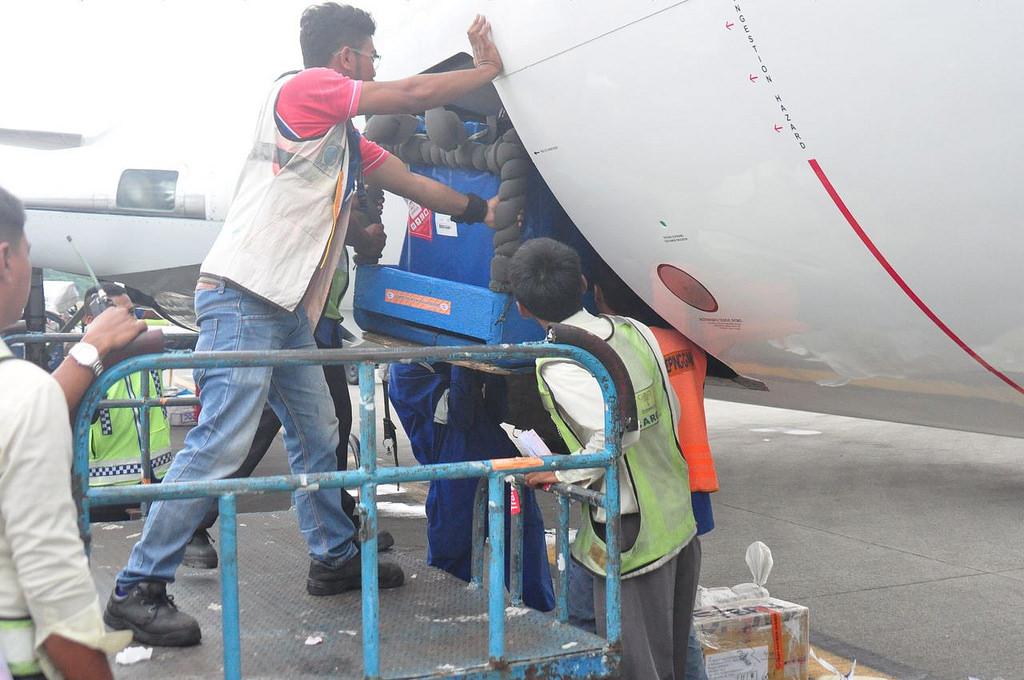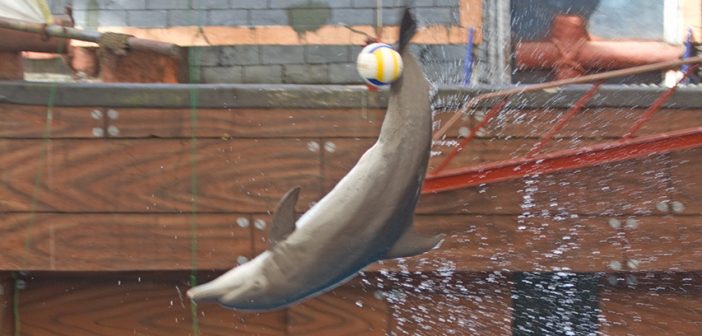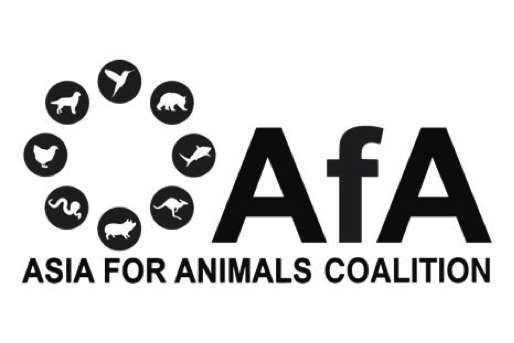Letter addressed to:
 Mr Chandra Lie
Mr Chandra Lie
CEO
Sriwijaya Air
Jalan Gunung Sahari Raya No. 13 Blok B 8-10
Pademangan
Jakarta Utara
Indonesia
February 2017
__
Dear Mr Lie,
We are writing on behalf of the Asia for Animals Coalition, representing international animal welfare and conservation organisations. We express our deep concern with regards to Sriwijaya Air transporting dolphins on behalf of the dolphin traveling circus operators, and thus facilitating the continued exploitation of dolphins for entertainment.

Dolphin being loaded or unloaded from Sriwijaya Air plane (image credit Animals Asia, CC BY-NC 2.0)
Confining dolphins in captivity presents serious welfare issues. Dolphins are wide-ranging, social animals and captivity lacks the social, visual and auditory stimuli of their natural environment. The welfare of dolphins used in traveling circuses is further compromised by their training, frequent transport, and the lack of suitable resting and holding facilities at circus venues. The dolphins are held in close confinement for almost all of their lives, forced to travel for hours on end, and exposed to regular human handling and excessive noise. Water quality is also an issue; the “tanks” for traveling circus dolphins are temporary and must use local water sources (of varying quality) and ordinary table salt to salinate the water.
Many of these dolphins have been captured from the wild and this also poses a huge welfare concern, as well as a conservation issue. The removal of individual dolphins from wild populations has serious implications for the survival of the targeted populations.
The capture is extremely traumatic and violent[1]:
- Families are separated from each other;
- Dolphins routinely die during the capture process;
- Studies are rarely conducted to ascertain what happens to those animals left behind;
- Once removed from their natural environment dolphins are transported to small enclosures which lack not only their families and social groups but also the open space to which they are accustomed;
- Research shows that death rates increase six-fold during and immediately after capture.[2]
Once confined, dolphins must adapt to an artificial diet, excessive noise and the proximity of people and unknown animals. Many suffer from the stress of confinement, which often results in increased aggression, illness and death.[3][4]

Dolphin transported aboard Sriwijaya Air plane (image credit Animals Asia, CC BY-NC 2.0)
No captive facility can provide adequate exercise for dolphins, which are capable of swimming up to 60 miles a day, can attain speeds up to 22 mph, and can dive to several hundred feet. They can also live for 40-60 years depending upon the species which is rarely, if ever, achieved in captivity, even though in captivity they don’t face mortality threats such as predation and lack of prey. Traveling circuses are even more problematic in this regard, holding dolphins in stretchers and small transport boxes for hours on end, causing further stress.
Forcing dolphins to perform is a risk to the animals’ health and welfare and is therefore in contravention of Article 29, para g[5]; and Article 30, para (2)f[6], of The Regulation of the Minister of Forestry of the Republic of Indonesia Number: P.31/Menhut-II/2012 on Conservation Agencies, and article 5, para 3[7]; article 16, para1[8]; article 16, para 2[9]; article 42, para a[10]; article 44, para 2[11] of the Director General of Forest Protection and Nature Conservation Regulation No. P.16/IV-SET/2014; Guidelines for dolphin exhibition.
There is growing international recognition of the role airlines play in permitting the captive cetacean industry to continue its exploitation, and of the severe stress cetaceans suffer during hours of restricted confinement during air transportation. Globally we are seeing an ever-growing number of airlines pledging to no longer transport these animals.
On behalf of our members globally, we urge Sriwijaya Air to end the transport of these dolphins and show your opposition to the continued exploitation of dolphins within the entertainment industry in Indonesia.
Sent on behalf of the following organisations:
- Animal Guardians
- Animal People
- Animals Asia Foundation
- ACRES
- Blue Cross of India
- Change for Animals Foundation
- Elephant Aid International
- Federation of Indian Animal Protection Organisations
- Humane Society International
- International Animal Rescue
- International Fund for Animal Welfare
- Philippine Animal Welfare Society
- Royal Society for the Prevention of Cruelty to Animals
- Society for the Prevention of Cruelty to Animals, Hong Kong
- Society for the Prevention of Cruelty to Animals, Sarawak, Malaysia
- World Animal Protection
__
(Featured image: dolphin performing somersault at a Taman Safari facility in East Java. Image credit Michael Jefferies, CC BY-NC 2.0 / cropped)
__
Copied to:
President Joko Widodo
President Republik Indonesia
Istana Negara
Jalan Medan Merdeka Utara
Jakarta Pusat 10110
Indonesia
president@ri.go.id
jokowi@gmail.com
Her Excellence Siti Nurbaya Bakar
Minister of Environment & Forestry
Republic of Indonesia
Gedung Manggala Wanabakti Blok I Lt. 3
Jalan Gatot Subroto – Senayan
Jakarta 10270
Indonesia
Sitinurbaya_bakar@yahoo.co.id
sitinurbaya.bakar@gmail.com
Drs. H. Muhammad Jusuf Kalla
Wakil President Republik Indonesia
Jl Medan Merdeka Selatan 6 Kel, Gambir
Jakarta Pusat. 10110
Indonesia
Drs. Setya Novanto, Ak
Chairman of House of Representatives (Dewan Perwakilan Rakyat)
Gedung Nusantara III
Jalan Jenderal Gatot Subroto
Jakarta 10270
Indonesia
Mr. Bambang Hendroyono
Secretary General
Ministry of Environment & Forestry Republic of Indonesia
Gedung Manggala Wanabakti Blok I Lt. 3
Jalan Gatot Subroto – Senayan – Jakarta – Indonesia – 10270
banghen_11@yahoo.co.id
datakonservasi@gmail.com
Mr. Rasio Ridho Sani
Director General of Law Enforcement
Ministry of Environment & Forestry Republic of Indonesia
Gedung Manggala Wanabakti Blok I Lt. 3
Jalan Gatot Subroto – Senayan – Jakarta – Indonesia – 10270
rasiosani@yahoo.com
Mr. Bambang Dahono Adji
Director
Directorate of Conservation & Biodiversity, Ministry of Forestry
Gedung Manggala Wanabakti Bld Block VII 7th Floor
Jalan Gatot Subroto
Senayan
Jakarta 10270
Indonesia
ditkkh@gmail.com
pemolaan@yahoo.com
Dr H Rahmat Shah
President
Indonesian Zoo and Aquarium Association (PKBSI)
Jl. Harsono RM
No 10 Ragunan
Jakarta, 12550
Indonesia
pkbsi@izaa.org
Tony Sumampau
Secretary General
Indonesian Zoo and Aquarium Association (PKBSI)
Jl. Harsono RM
No 10 Ragunan
Jakarta, 12550
Indonesia
tsumampau@hotmail.com
__
Citations:
[1] C. S. Vail and D. Risch Driven by Demand: Dolphin Drive Hunts in Japan and the Involvement of the Aquarium Industry (Chippenham, United Kingdom: WDCS, 2006) http://www.wdcs.org/submissions_bin/drivenbydemand.pdf
[2] R. J. Small and D. P. DeMaster, “Acclimation to captivity: A quantitative estimate based on survival of bottlenose dolphins and California sea lions,” Marine Mammal Science 11 (1995): 510–519
[3] A. Samuels and T. Gifford, “A qualitative assessment of dominance relations amongst bottlenose dolphins,” Marine Mammal Science 13 (1997): 70–99
[4] K. A. Waples and N. J. Gales, “Evaluating and minimizing social stress in the care of captive bottlenose dolphins (Tursiops aduncus),” Zoo Biology 21 (2002): 5–26.
[5] holders of conservation agencies are prohibited from neglecting animals or managing animals not in accordance with animal ethics and welfare (Article 29, para g)
[6] holders of conservation agencies are obliged to intensively manage the conservation agency in accordance with ethics and animal welfare (Article 30, para (2)f),
[7] The pool … must consist of main pool, holding pool and isolation pool
[8] Protection … is conducted to protect the dolphin from disturbances due to human activities among other noise, physical disturbance to the dolphins and throwing things into the pool
[9] Protection… is conducted among other by means of physical boundary sign around the pool and putting up warning signs.
[10] Exhibition must be conducted by attending to animal ethics and welfare
[11] The types of exhibition as referred to in paragraph (1) may not deviate from the natural behaviour of the dolphin






